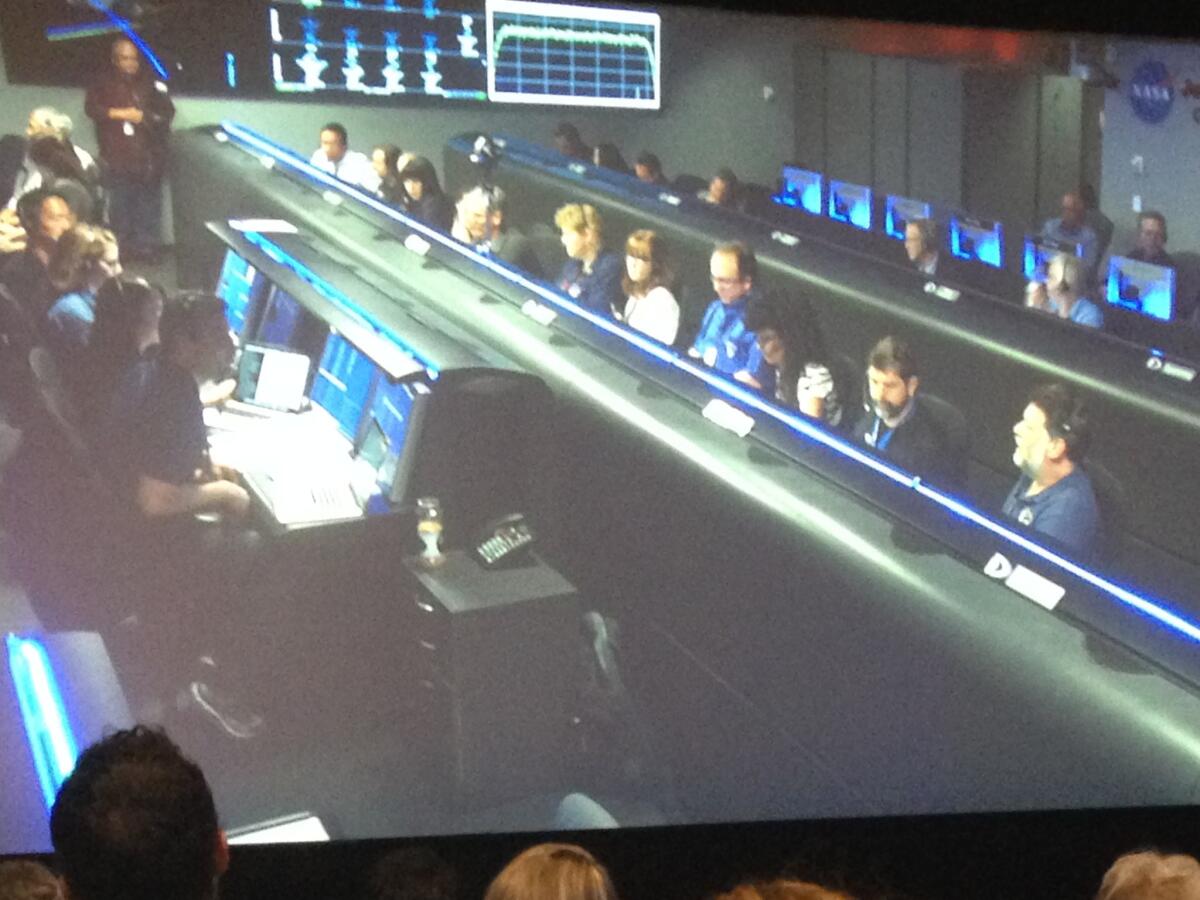Waiting for Cassini: Scenes from a late night at NASA’s Jet Propulsion Laboratory

Here’s what it was like at JPL as scientists and engineers awaited word that the Cassini spacecraft had survived its close encounter with Saturn.
- Share via
To protect Cassini from damaging encounters with dust or particles from Saturn’s rings, mission planners at the Jet Propulsion Laboratory had it fly through the previously unexplored region with its dish-shaped antenna leading the way. That shielded the spacecraft’s more delicate instruments from unexpected danger.
However, this also meant that the antenna couldn’t do its usual job of communicating with Earth. So the folks at NASA had to wait until Cassini had cleared the danger zone to find out if the spacecraft had survived intact— a time when most of us would already be sound asleep.
To help Cassini staffers pass the anxious late-night hours, JPL organized a friends-and-family event in the Von Karman Auditorium at campus in La Cañada Flintridge. The festivities were complete with singing, science talks and lots of coffee. And, of course, the first peek at Cassini’s most extreme close-ups of Saturn.
After all, if you’re going to fret about the health of your spacecraft, you might as well be with a bunch of scientists and engineers while you do it.
(And your friendly neighborhood science reporter, of course!)
Cassini Virtual Singers
Among Cassini’s many other notable achievements, it may be the only spacecraft with its own choir.
The Cassini Virtual Singers is a 10-member choral group made up of technicians, scientists and engineers who work on the mission.
“Our first aim is to be funny,” said Todd Barber, Cassini’s lead propulsion engineer and the self-appointed “musical conscience” of the group.

The repertoire consists entirely of popular songs with altered words to make them Cassini-relevant.
Wednesday evening’s set began with a customized rendition of “My Bonnie Lies Over the Ocean.”
Bring back, bring back, oh bring back the data to me, to me …
They also performed “The Sound of Science” to the tune of “The Sound of Silence.” The tune, which begins “Hello Cassini my old friend,” conveys the anxiety of realizing that the spacecraft has gone into safe mode.
And in the midnight meeting called,
Ten thousand people, maybe more,
People talking without thinking,
People typing without muting…
There was also a particularly rousing rendition of “The Age of the Proximals,” sung to the tune of “Aquarius/Let the Sunshine In” from the musical “Hair.” (NASA is calling the new orbits proximal orbits, since they will take Cassini closer to Saturn than it ever has been before.)
The choral group formed in 1997, just a few months after Cassini’s launch. They generally practice once a week, but they’d bumped that up before their performance.
“We’ve been practicing in a conference room every day at lunch for two weeks — to the chagrin of our neighbors,” Barber said.
What do you wear to a Cassini event?
How about an awesome beaded necklace that depicts the solar system!
Pictured below is just such an accessory. It was worn by Jane Houston Jones, who has spent the past 14 years working as the senior outreach specialist for the Cassini mission.
(She’s also the friendly voice of NASA’s monthly skywatching video series “What’s Up?”)
Jones said the necklace arrived as a kit, but she customized it a little. If you look closely, you’ll notice that her Saturn is accompanied by three colored beads that represent three of her favorite Saturnian moons —Titan, Enceladus and Iapetus.
Take an even closer look and you’ll spot the small gold bead just past those three.
“That’s my Cassini!” Houston Jones said.
I also applaud the vintage Saturn Orbit Insertion (SOI) badge she got back in 2004.
If you got it, flaunt it!
And finally, the good news
Around 11:50 p.m. the auditorium became very quiet. All eyes were focused on a giant screen on the stage.
They were watching the scene in the mission support area a few buildings away, where a couple dozen people with headsets sat intently. They were not talking.
(There’s nothing quite like a silent roomful of people watching a silent roomful of people.)

The atmosphere grew tense.
We’d been warned that the signal from Cassini indicating that it was OK would not arrive any earlier than 11:55 p.m.
But the anxiety was palpable. What if it never came at all?
And then, at 11:56 p.m., relief came in the form of a green line. It jumped onto the screen, announcing that Cassini was OK.
The people in the auditorium cheered. On the screen, Barber did an old fashioned fist pump — the universal signal for “YES!”
But he didn’t break into song.
Do you love science? I do! Follow me @DeborahNetburn and "like" Los Angeles Times Science & Health on Facebook.
MORE IN SCIENCE
Spacecraft Cassini's first pass between Saturn and its rings goes flawlessly
After 13 years at Saturn, NASA’s Cassini spacecraft is ready for its grand finale
Scientists get a rare view of a type Ia supernova magnified 50 times




